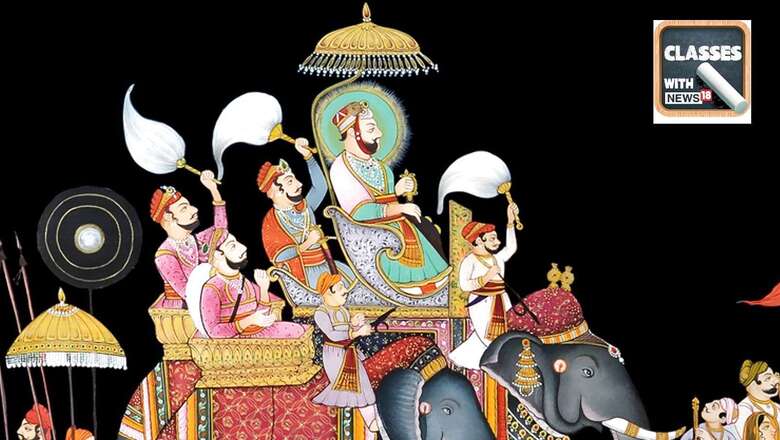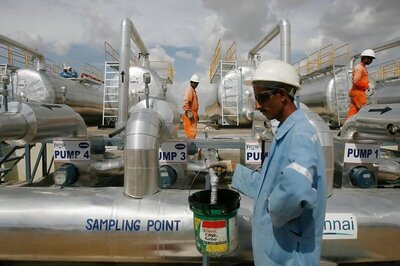
views
In this week’s class with News18, we are discussing the rise and fall of the Mughal empire. The Mughals were descendants of two lineages of rulers — Genghis Khan (died 1227), ruler of the Mongol tribes, China and Central Asia. From their father’s side, they were the successors of Timur (died 1404), who was the ruler of Iran, Iraq and modern-day Turkey. The Mughals under the Timurid ancestry seized Delhi in 1398. Here we take a look how the Mughals captured India, and what were the events that led to their downfall, as mentioned in the NCERT history book.
A Timeline of Important Events During Mughal Reign
Babur- 1526-1530
1526 — Babur defeated Ibrahim Lodi and his Afghan supporters at Panipat.
1527 — Babur defeated Rana Sanga, Rajput rulers and allies at Khanua.
1528 — Babur defeated the Rajputs at Chanderi. He established control over Agra and Delhi before his death.
Humayun — 1530-1540, 1555-1556
After the death of Babur, Humayun divided his inheritance according to the will of his father. His brothers were each given a province. The ambitions of his brother, Mirza Kamran, however, weakened the Mughals against their Afghan competitors.
1539-40 — Sher Khan defeated Humayun at Chausa and Kanauj, thus, forcing him to flee to Iran. Over there, Humayun received help from the Safavid Shah.
1555 — Humayun recaptured Delhi but died the next year after an accident in this building.
Akbar — 1556-1605
After the death of Humayun, Akbar became emperor at the age of 13. His reign can be divided into three periods.
1556-1570 — Akbar became independent of the regent Bairam Khan.
1568 — The Sisodiya capital of Chittor was seized by him
1569 — He captured Ranthambhore.
1570-1585– Military campaigns in Gujarat, Bihar, Bengal and Orissa. These campaigns, however, were complicated by the 1579-1580 revolt in support of Mirza Hakim.
1585-1605 — Akbar’s empire expanded. Campaigns were launched in the north-west. Qandahar was seized, Kashmir was annexed, as well as Kabul, after the death of Mirza Hakim. Military campaigns began in the Deccan and Berar, Khandesh, and parts of Ahmadnagar were annexed. In the last years of his reign, Akbar was distracted by Prince Salim, the future Emperor Jahangir.
Jahangir — 1605-1627
Military campaigns started by Akbar continued. The Sisodiya ruler of Mewar, Amar Singh, accepted Mughal service. Campaigns were held against the Sikhs, the Ahoms and Ahmadnagar but were not very successful. Prince Khurram or Shah Jahan, rebelled against Jahangir, in the last years of his reign. The efforts of Nur Jahan, Jahangir’s wife, to marginalise him were unsuccessful.
Shah Jahan 1627-1658
Mughal campaigns continued in the Deccan under Shah Jahan. The Afghan noble Khan Jahan Lodi rebelled and was defeated. Campaigns were launched against Ahmadnagar, the Bundelas were defeated and Orchha seized. In the north-west, the campaign to seize Balkh from the Uzbegs was unsuccessful and Qandahar was lost to the Safavids.
1632 — Ahmadnagar was finally annexed, Bijapur forces sued for peace.
1657-1658 — Conflict over succession amongst Shah Jahan’s sons. Aurangzeb was victorious and his three brothers, including Dara Shukoh, were killed. Shah Jahan was imprisoned for the rest of his life in Agra.
Aurangzeb 1658-1707
1663 — The Ahoms were defeated but rebelled again in the 1680s. Campaigns in the north-west against the Yusufzai and the Sikhs were temporarily successful. Mughal intervention in the succession and internal politics of the Rathor Rajputs of Marwar also led to their rebellion.
Campaigns against the Maratha chief Shivaji were initially successful. Aurangzeb, however, insulted Shivaji, who escaped from Agra, and declared himself an independent king. He resumed his campaigns against the Mughals. Prince Akbar rebelled against Aurangzeb and received support from the Marathas and the Deccan Sultanate. He finally fled to Safavid Iran.
1658 — Bijapur was annexed
1687 — Golconda was annexed.
1698 — Aurangzeb personally managed campaigns in the Deccan against the Marathas, who began guerrilla warfare. Aurangzeb faced rebellion in north India of the Sikhs, Jats and Satnamis, in the north-east of the Ahoms and in the Deccan of the Marathas.
1707: Aurangzeb dies. His death was followed by a succession conflict amongst his sons.
Mansabdars and their role in the downfall of the Mughals
As the Mughal empire continued to expand, several people were recruited across different military levels. From Turkish nobles to Iranians, Indian Muslims, Afghans, Rajputs, Marathas and other groups joined Mughal service. They were enrolled as mansabdars. It refers to an individual who holds a mansab or a position/rank. The Mughals fixed rank and salary by a numerical value called zat. The higher the zat, the more prestigious was the position in court and the bigger the salary.
Role and responsibilities — The mansabdar’s military responsibilities included maintaining a specified number of sawar or cavalrymen. The mansabdar brought his cavalrymen for review, got them registered, their horses branded and then received money to pay them as salary.
Mansabdars received their salaries as revenue assignments called jagirs. They had rights to the revenue of their assignments which was collected for them by their servants while the mansabdars themselves served in some other part of the country.
During Akbar’s reign, the jagirs were carefully assessed so that their revenues were roughly equal to the salary of the mansabdar. By Aurangzeb’s reign this was no longer the case and the actual revenue collected was often less than the granted sum. There was also a huge increase in the number of mansabdars, which meant a long wait before they received a jagir. This created a shortage in the number of jagirs. They tried to extract as much revenue as possible. Later, Aurangzeb was unable to control these developments in the last years of his reign and the peasantry suffered tremendously.
The Downfall
The Mughal Empire reached the height of its success but soon started facing several crisis towards the end of 17th century. This was due to a number of factors. Emperor Aurangzeb had depleted the military and financial resources of his empire due to a long war in the Deccan.
Further, under his successors, the administration broke down. The later Mughal emperors were unable to keep a check on their powerful mansabdars. Nobles appointed as governors or subadars, often controlled the offices of revenue and military administration which were known as diwani and faujdari, respectively. This gave them tremendous political, economic, and military powers over the Mughal empire.
As the governors took control over the provinces, the capital declined. Peasant and zamindari rebellions in several parts of northern and western India made the problems worse. These revolts were sometimes caused by the pressures of mounting taxes.
At the same time, there were attempts by powerful chieftains to consolidate their own positions. Mughal Empire had been challenged by rebellious groups in the past as well but now they were able to seize the economic resources of the region.
The Mughal emperors after Aurangzeb were unable to handle the situation that led to the political and economic crisis — the authority of which finally went into the hands of provincial governors, local chieftains and other groups. Amid all these, the ruler of Iran, Nadir Shah invaded Delhi in 1739 and took away immense amounts of wealth. This was followed by raids by the Afghan ruler Ahmad Shah Abdali, who invaded north India five times between 1748 and 1761.
This led to the ultimate downfall of the Mughals and the rise of the governors.
To learn about other topics taught in school, explained by News18, here is a list of other Classes With News18: Queries Related to Civics Chapter on ‘Elections’ | Sex Versus Gender | Natural Disasters | Wonderland of Letters | Civil Wars | Cryptocurrencies | Economy & Banks | Silk Route
Read all the Latest News, Breaking News, watch Top Videos and Live TV here.




















Comments
0 comment